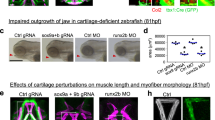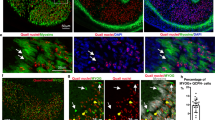Abstract
The early vertebrate skeletal muscle is a well-organized tissue in which the primitive muscle fibres, the myocytes, are all parallel and aligned along the antero-posterior axis of the embryo. How myofibres acquire their orientation during development is unknown. Here we show that during early chick myogenesis WNT11 has an essential role in the oriented elongation of the myocytes. We find that the neural tube, known to drive WNT11 expression in the medial border of somites1, is necessary and sufficient to orient myocyte elongation. We then show that the specific inhibition of WNT11 function in somites leads to the disorganization of myocytes. We establish that WNT11 mediates this effect through the evolutionary conserved planar cell polarity (PCP) pathway, downstream of the WNT/β-catenin-dependent pathway, required to initiate the myogenic program of myocytes and WNT11 expression. Finally, we demonstrate that a localized ectopic source of WNT11 can markedly change the orientation of myocytes, indicating that WNT11 acts as a directional cue in this process. All together, these data show that the sequential action of the WNT/PCP and the WNT/β-catenin pathways is necessary for the formation of fully functional embryonic muscle fibres. This study also provides evidence that WNTs can act as instructive cues to regulate the PCP pathway in vertebrates.
This is a preview of subscription content, access via your institution
Access options
Subscribe to this journal
Receive 51 print issues and online access
$199.00 per year
only $3.90 per issue
Buy this article
- Purchase on Springer Link
- Instant access to full article PDF
Prices may be subject to local taxes which are calculated during checkout




Similar content being viewed by others
References
Marcelle, C., Stark, M. R. & Bronner-Fraser, M. Coordinate actions of BMPs, Wnts, Shh and noggin mediate patterning of the dorsal somite. Development 124, 3955–3963 (1997)
Gros, J., Scaal, M. & Marcelle, C. A two-step mechanism for myotome formation in chick. Dev. Cell 6, 875–882 (2004)
Kahane, N., Ben-Yair, R. & Kalcheim, C. Medial pioneer fibers pattern the morphogenesis of early myoblasts derived from the lateral somite. Dev. Biol. 305, 439–450 (2007)
Ikeya, M. & Takada, S. Wnt signaling from the dorsal neural tube is required for the formation of the medial dermomyotome. Development 125, 4969–4976 (1998)
Heisenberg, C. P. et al. Silberblick/Wnt11 mediates convergent extension movements during zebrafish gastrulation. Nature 405, 76–81 (2000)
Tada, M. & Smith, J. C. Xwnt11 is a target of Xenopus Brachyury: regulation of gastrulation movements via Dishevelled, but not through the canonical Wnt pathway. Development 127, 2227–2238 (2000)
Voiculescu, O., Bertocchini, F., Wolpert, L., Keller, R. E. & Stern, C. D. The amniote primitive streak is defined by epithelial cell intercalation before gastrulation. Nature 449, 1049–1052 (2007)
Das, R. M. et al. A robust system for RNA interference in the chicken using a modified microRNA operon. Dev. Biol. 294, 554–563 (2006)
Klein, T. J. & Mlodzik, M. Planar cell polarization: an emerging model points in the right direction. Annu. Rev. Cell Dev. Biol. 21, 155–176 (2005)
Wallingford, J. B. et al. Dishevelled controls cell polarity during Xenopus gastrulation. Nature 405, 81–85 (2000)
Wang, Y. & Nathans, J. Tissue/planar cell polarity in vertebrates: new insights and new questions. Development 134, 647–658 (2007)
Linker, C., Lesbros, C., Stark, M. R. & Marcelle, C. Intrinsic signals regulate the initial steps of myogenesis in vertebrates. Development 130, 4797–4807 (2003)
Djiane, A., Riou, J., Umbhauer, M., Boucaut, J. & Shi, D. Role of frizzled 7 in the regulation of convergent extension movements during gastrulation in Xenopus laevis . Development 127, 3091–3100 (2000)
Witzel, S., Zimyanin, V., Carreira-Barbosa, F., Tada, M. & Heisenberg, C. P. Wnt11 controls cell contact persistence by local accumulation of Frizzled 7 at the plasma membrane. J. Cell Biol. 175, 791–802 (2006)
Bhanot, P. et al. A new member of the frizzled family from Drosophila functions as a Wingless receptor. Nature 382, 225–230 (1996)
Seifert, J. R. & Mlodzik, M. Frizzled/PCP signalling: a conserved mechanism regulating cell polarity and directed motility. Nature Rev. Genet. 8, 126–138 (2007)
Cooper, O., Sweetman, D., Wagstaff, L. & Munsterberg, A. Expression of avian prickle genes during early development and organogenesis. Dev. Dyn. 237, 1442–1448 (2008)
Axelrod, J. D., Miller, J. R., Shulman, J. M., Moon, R. T. & Perrimon, N. Differential recruitment of Dishevelled provides signaling specificity in the planar cell polarity and Wingless signaling pathways. Genes Dev. 12, 2610–2622 (1998)
Rothbacher, U. et al. Dishevelled phosphorylation, subcellular localization and multimerization regulate its role in early embryogenesis. EMBO J. 19, 1010–1022 (2000)
Marlow, F., Topczewski, J., Sepich, D. & Solnica-Krezel, L. Zebrafish Rho kinase 2 acts downstream of Wnt11 to mediate cell polarity and effective convergence and extension movements. Curr. Biol. 12, 876–884 (2002)
Tao, Q. et al. Maternal wnt11 activates the canonical wnt signaling pathway required for axis formation in Xenopus embryos. Cell 120, 857–871 (2005)
Borello, U. et al. The Wnt/beta-catenin pathway regulates Gli-mediated Myf5 expression during somitogenesis. Development 133, 3723–3732 (2006)
Boutros, M., Paricio, N., Strutt, D. I. & Mlodzik, M. Dishevelled activates JNK and discriminates between JNK pathways in planar polarity and wingless signaling. Cell 94, 109–118 (1998)
Li, L. et al. Dishevelled proteins lead to two signaling pathways. Regulation of LEF-1 and c-Jun N-terminal kinase in mammalian cells. J. Biol. Chem. 274, 129–134 (1999)
Bastock, R., Strutt, H. & Strutt, D. Strabismus is asymmetrically localised and binds to Prickle and Dishevelled during Drosophila planar polarity patterning. Development 130, 3007–3014 (2003)
Park, T. J., Gray, R. S., Sato, A., Habas, R. & Wallingford, J. B. Subcellular localization and signaling properties of dishevelled in developing vertebrate embryos. Curr. Biol. 15, 1039–1044 (2005)
Torban, E. et al. Genetic interaction between members of the Vangl family causes neural tube defects in mice. Proc. Natl Acad. Sci. USA 105, 3449–3454 (2008)
Jiang, D., Munro, E. M. & Smith, W. C. Ascidian prickle regulates both mediolateral and anterior-posterior cell polarity of notochord cells. Curr. Biol. 15, 79–85 (2005)
Wang, J. et al. Dishevelled genes mediate a conserved mammalian PCP pathway to regulate convergent extension during neurulation. Development 133, 1767–1778 (2006)
Gros, J., Manceau, M., Thome, V. & Marcelle, C. A common somitic origin for embryonic muscle progenitors and satellite cells. Nature 435, 954–958 (2005)
Linker, C. et al. β-catenin-dependent Wnt signalling controls the epithelial organisation of somites through the activation of paraxis. Development 132, 3895–3905 (2005)
Montross, W. T., Ji, H. & McCrea, P. D. A β-catenin/engrailed chimera selectively suppresses Wnt signaling. J. Cell Sci. 113, 1759–1770 (2000)
Kengaku, M. et al. Distinct WNT pathways regulating AER formation and dorsoventral polarity in the chick limb bud. Science 280, 1274–1277 (1998)
Anakwe, K. et al. 16 Wnt regulation of limb muscle differentiation. J. Anat. 201, 421 (2002)
Morin, X., Jaouen, F. & Durbec, P. Control of planar divisions by the G-protein regulator LGN maintains progenitors in the chick neuroepithelium. Nature Neurosci. 10, 1440–1448 (2007)
Acknowledgements
We thank C. Tabin for critical reading of the manuscript. The help of P. Weber for the two-photon imaging, and of the Zeiss team, are acknowledged. We are grateful to M. Manceau for Supplementary Fig. 1d, and to R. Kanadia for his help. This study was funded by grants from the Actions Concertées Incitatives (ACI), the Agence Nationale de la Recherche (ANR), the Association Française contre les Myopathies (AFM) and by the EU 6th Framework Programme Network of Excellence MYORES. J.G. was a Fellow of the AFM.
Author information
Authors and Affiliations
Corresponding author
Supplementary information
Supplementary Information
This file contains Supplementary Figures 1-5 with `Legends, Supplementary Methods and Supplementary References (PDF 4386 kb)
Supplementary Movie 1
Supplementary Movie 1 shows a 3D reconstruction of a series of 2-photons confocal views (Z-stack) of a somite, 24 hours after electroporation with GFP within the Dorso-Medial Lip (DML). The movie shows the typical bottle-shape morphology of epithelial cells of the DML (in green), of mesenchymal protrusive cells in the transition zone (in blue), and of fully elongated myocytes (in red). (MOV 2254 kb)
Supplementary Movie 2
Supplementary Movie 2 shows a time lapse observation of GFP-electroporated protrusive mesenchymal cells within the transition zone. The movie shows that these cells display an intense protrusive activity characterized by the formation of filopodia extending in all directions and by the generation of lamellipodia at the cell periphery. (MOV 2063 kb)
Supplementary Movie 3
Supplementary Movie 3 shows a time lapse observation of GFP-electroporated cells elongating in the antero-posterior axis of the embryo. The shape of two cells (in red and blue) has been outlined for more clarity. The movie shows that one of them (in red) is elongating in one direction, the second (in blue) in both directions. The formation of full-size myocytes is achieved by an extensive cell elongation driven by the progression of the lamellipodia along the antero-posterior axis of the embryo. (MOV 5462 kb)
Rights and permissions
About this article
Cite this article
Gros, J., Serralbo, O. & Marcelle, C. WNT11 acts as a directional cue to organize the elongation of early muscle fibres. Nature 457, 589–593 (2009). https://doi.org/10.1038/nature07564
Received:
Accepted:
Published:
Issue Date:
DOI: https://doi.org/10.1038/nature07564
This article is cited by
-
Directionality of developing skeletal muscles is set by mechanical forces
Nature Communications (2023)
-
Planar cell polarity pathway in kidney development, function and disease
Nature Reviews Nephrology (2021)
-
TGFβ signalling acts as a molecular brake of myoblast fusion
Nature Communications (2021)
-
Characterising open chromatin in chick embryos identifies cis-regulatory elements important for paraxial mesoderm formation and axis extension
Nature Communications (2021)
-
PCP and Wnt pathway components act in parallel during zebrafish mechanosensory hair cell orientation
Nature Communications (2019)
Comments
By submitting a comment you agree to abide by our Terms and Community Guidelines. If you find something abusive or that does not comply with our terms or guidelines please flag it as inappropriate.



